+ Open data
Open data
- Basic information
Basic information
| Entry | Database: PDB / ID: 2n1w | ||||||
|---|---|---|---|---|---|---|---|
| Title | Solution structure of human SUMO2 | ||||||
 Components Components | Small ubiquitin-related modifier 2 | ||||||
 Keywords Keywords | STRUCTURAL GENOMICS / Ubiquitin-like protein | ||||||
| Function / homology |  Function and homology information Function and homology informationSUMO is proteolytically processed / SUMO is conjugated to E1 (UBA2:SAE1) / SUMO is transferred from E1 to E2 (UBE2I, UBC9) / Vitamin D (calciferol) metabolism / SUMOylation of SUMOylation proteins / SUMOylation of RNA binding proteins / SUMO transferase activity / SUMOylation of transcription factors / ubiquitin-like protein ligase binding / SUMOylation of DNA replication proteins ...SUMO is proteolytically processed / SUMO is conjugated to E1 (UBA2:SAE1) / SUMO is transferred from E1 to E2 (UBE2I, UBC9) / Vitamin D (calciferol) metabolism / SUMOylation of SUMOylation proteins / SUMOylation of RNA binding proteins / SUMO transferase activity / SUMOylation of transcription factors / ubiquitin-like protein ligase binding / SUMOylation of DNA replication proteins / protein sumoylation / postsynaptic cytosol / SUMOylation of DNA damage response and repair proteins / presynaptic cytosol / SUMOylation of transcription cofactors / hippocampal mossy fiber to CA3 synapse / SUMOylation of chromatin organization proteins / Regulation of endogenous retroelements by KRAB-ZFP proteins / SUMOylation of intracellular receptors / PML body / GABA-ergic synapse / protein tag activity / Formation of Incision Complex in GG-NER / positive regulation of proteasomal ubiquitin-dependent protein catabolic process / Processing of DNA double-strand break ends / ubiquitin protein ligase binding / glutamatergic synapse / positive regulation of transcription by RNA polymerase II / RNA binding / nucleoplasm / nucleus Similarity search - Function | ||||||
| Biological species |  Homo sapiens (human) Homo sapiens (human) | ||||||
| Method | SOLUTION NMR / torsion angle dynamics, DGSA-distance geometry simulated annealing | ||||||
| Model details | lowest energy, model1 | ||||||
 Authors Authors | Naik, M.T. / Naik, N. / Shih, H. / Huang, T. | ||||||
 Citation Citation |  Journal: To Be Published Journal: To Be PublishedTitle: Structures of human SUMO Authors: Naik, M.T. / Naik, N. / Shih, H. / Huang, T. | ||||||
| History |
|
- Structure visualization
Structure visualization
| Structure viewer | Molecule:  Molmil Molmil Jmol/JSmol Jmol/JSmol |
|---|
- Downloads & links
Downloads & links
- Download
Download
| PDBx/mmCIF format |  2n1w.cif.gz 2n1w.cif.gz | 572.1 KB | Display |  PDBx/mmCIF format PDBx/mmCIF format |
|---|---|---|---|---|
| PDB format |  pdb2n1w.ent.gz pdb2n1w.ent.gz | 479.7 KB | Display |  PDB format PDB format |
| PDBx/mmJSON format |  2n1w.json.gz 2n1w.json.gz | Tree view |  PDBx/mmJSON format PDBx/mmJSON format | |
| Others |  Other downloads Other downloads |
-Validation report
| Summary document |  2n1w_validation.pdf.gz 2n1w_validation.pdf.gz | 539.9 KB | Display |  wwPDB validaton report wwPDB validaton report |
|---|---|---|---|---|
| Full document |  2n1w_full_validation.pdf.gz 2n1w_full_validation.pdf.gz | 899 KB | Display | |
| Data in XML |  2n1w_validation.xml.gz 2n1w_validation.xml.gz | 58.7 KB | Display | |
| Data in CIF |  2n1w_validation.cif.gz 2n1w_validation.cif.gz | 77.9 KB | Display | |
| Arichive directory |  https://data.pdbj.org/pub/pdb/validation_reports/n1/2n1w https://data.pdbj.org/pub/pdb/validation_reports/n1/2n1w ftp://data.pdbj.org/pub/pdb/validation_reports/n1/2n1w ftp://data.pdbj.org/pub/pdb/validation_reports/n1/2n1w | HTTPS FTP |
-Related structure data
| Related structure data | 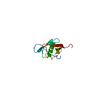 2n1vC  2n1x  2n1y  2n1z  2n20 C: citing same article ( |
|---|---|
| Similar structure data | |
| Other databases |
- Links
Links
- Assembly
Assembly
| Deposited unit | 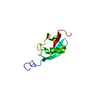
| |||||||||
|---|---|---|---|---|---|---|---|---|---|---|
| 1 |
| |||||||||
| NMR ensembles |
|
- Components
Components
| #1: Protein | Mass: 12242.603 Da / Num. of mol.: 1 / Fragment: UNP residues 1-93 Source method: isolated from a genetically manipulated source Source: (gene. exp.)  Homo sapiens (human) Homo sapiens (human)Description: Plasmid pCDF PylT-1 with SUMO2 insert and pAcKRS-3 as described in Neumann et al., Mol Cell, 36, 153, 2009 Gene: SMT3B, SMT3H2, SUMO2 / Production host:  |
|---|
-Experimental details
-Experiment
| Experiment | Method: SOLUTION NMR Details: Solution structure of Small Ubiquitin-related MOdifier 2. | ||||||||||||||||||||||||||||||||||||||||||||||||||||||||||||||||||||||||
|---|---|---|---|---|---|---|---|---|---|---|---|---|---|---|---|---|---|---|---|---|---|---|---|---|---|---|---|---|---|---|---|---|---|---|---|---|---|---|---|---|---|---|---|---|---|---|---|---|---|---|---|---|---|---|---|---|---|---|---|---|---|---|---|---|---|---|---|---|---|---|---|---|---|
| NMR experiment |
| ||||||||||||||||||||||||||||||||||||||||||||||||||||||||||||||||||||||||
| NMR details | Text: NMR data was acquired at 295K using Shigemi NMR tubes. |
- Sample preparation
Sample preparation
| Details |
| ||||||||||||||||||||||||||||||||||||||||||||||||||||||||||||||||||||||||||||||||||||||||||||||||||||||||||||||||||||||||||||||||||||||||||||||||||||||||||||
|---|---|---|---|---|---|---|---|---|---|---|---|---|---|---|---|---|---|---|---|---|---|---|---|---|---|---|---|---|---|---|---|---|---|---|---|---|---|---|---|---|---|---|---|---|---|---|---|---|---|---|---|---|---|---|---|---|---|---|---|---|---|---|---|---|---|---|---|---|---|---|---|---|---|---|---|---|---|---|---|---|---|---|---|---|---|---|---|---|---|---|---|---|---|---|---|---|---|---|---|---|---|---|---|---|---|---|---|---|---|---|---|---|---|---|---|---|---|---|---|---|---|---|---|---|---|---|---|---|---|---|---|---|---|---|---|---|---|---|---|---|---|---|---|---|---|---|---|---|---|---|---|---|---|---|---|---|---|
| Sample |
| ||||||||||||||||||||||||||||||||||||||||||||||||||||||||||||||||||||||||||||||||||||||||||||||||||||||||||||||||||||||||||||||||||||||||||||||||||||||||||||
| Sample conditions | pH: 6.5 / Pressure: ambient atm / Temperature: 290 K |
-NMR measurement
| NMR spectrometer |
|
|---|
- Processing
Processing
| NMR software |
| ||||||||||||||||||||||||||||||||||||||||
|---|---|---|---|---|---|---|---|---|---|---|---|---|---|---|---|---|---|---|---|---|---|---|---|---|---|---|---|---|---|---|---|---|---|---|---|---|---|---|---|---|---|
| Refinement | Method: torsion angle dynamics, DGSA-distance geometry simulated annealing Software ordinal: 1 Details: Initial structure ensemble was calculated by semi-automated NOESY assignment by CYANA. The assignments were manually verified in Sparky and final structure annealing was performed in CYANA. ...Details: Initial structure ensemble was calculated by semi-automated NOESY assignment by CYANA. The assignments were manually verified in Sparky and final structure annealing was performed in CYANA.Structure and restraints from CYANA were imported in Xplor-NIH for explicit water refinement., Initial structure ensemble was calculated by semi-automated NOESY assignment by CYANA. The assignments were manually verified in Sparky and final structure annealing was performed in CYANA.Structure and restraints from CYANA were imported in Xplor-NIH for explicit water refinement. | ||||||||||||||||||||||||||||||||||||||||
| NMR constraints | NOE constraints total: 2519 / NOE intraresidue total count: 526 / NOE long range total count: 902 / NOE medium range total count: 453 / NOE sequential total count: 638 / Disulfide bond constraints total count: 0 / Hydrogen bond constraints total count: 56 / Protein chi angle constraints total count: 0 / Protein other angle constraints total count: 0 / Protein phi angle constraints total count: 68 / Protein psi angle constraints total count: 68 | ||||||||||||||||||||||||||||||||||||||||
| NMR representative | Selection criteria: lowest energy | ||||||||||||||||||||||||||||||||||||||||
| NMR ensemble | Conformer selection criteria: structures with the lowest energy Conformers calculated total number: 400 / Conformers submitted total number: 20 / Maximum distance constraint violation: 0.77 Å / Maximum torsion angle constraint violation: 5 ° / Representative conformer: 1 / Torsion angle constraint violation method: PSVS 1.5 | ||||||||||||||||||||||||||||||||||||||||
| NMR ensemble rms | Distance rms dev: 0.03 Å |
 Movie
Movie Controller
Controller






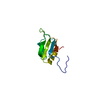

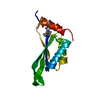
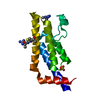
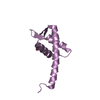

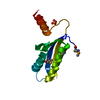
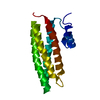
 PDBj
PDBj












 HSQC
HSQC